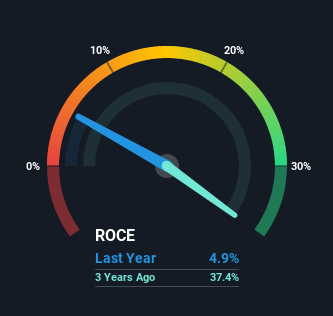- Hong Kong
- /
- Professional Services
- /
- SEHK:1463
Be Wary Of C-Link Squared (HKG:1463) And Its Returns On Capital
If we want to find a potential multi-bagger, often there are underlying trends that can provide clues. One common approach is to try and find a company with returns on capital employed (ROCE) that are increasing, in conjunction with a growing amount of capital employed. This shows us that it's a compounding machine, able to continually reinvest its earnings back into the business and generate higher returns. Although, when we looked at C-Link Squared (HKG:1463), it didn't seem to tick all of these boxes.
Understanding Return On Capital Employed (ROCE)
If you haven't worked with ROCE before, it measures the 'return' (pre-tax profit) a company generates from capital employed in its business. To calculate this metric for C-Link Squared, this is the formula:
Return on Capital Employed = Earnings Before Interest and Tax (EBIT) ÷ (Total Assets - Current Liabilities)
0.049 = RM4.6m ÷ (RM106m - RM11m) (Based on the trailing twelve months to June 2021).
Therefore, C-Link Squared has an ROCE of 4.9%. In absolute terms, that's a low return and it also under-performs the IT industry average of 6.3%.
See our latest analysis for C-Link Squared

Historical performance is a great place to start when researching a stock so above you can see the gauge for C-Link Squared's ROCE against it's prior returns. If you're interested in investigating C-Link Squared's past further, check out this free graph of past earnings, revenue and cash flow.
What Can We Tell From C-Link Squared's ROCE Trend?
When we looked at the ROCE trend at C-Link Squared, we didn't gain much confidence. Over the last four years, returns on capital have decreased to 4.9% from 36% four years ago. Although, given both revenue and the amount of assets employed in the business have increased, it could suggest the company is investing in growth, and the extra capital has led to a short-term reduction in ROCE. If these investments prove successful, this can bode very well for long term stock performance.
On a related note, C-Link Squared has decreased its current liabilities to 10% of total assets. That could partly explain why the ROCE has dropped. What's more, this can reduce some aspects of risk to the business because now the company's suppliers or short-term creditors are funding less of its operations. Since the business is basically funding more of its operations with it's own money, you could argue this has made the business less efficient at generating ROCE.
What We Can Learn From C-Link Squared's ROCE
While returns have fallen for C-Link Squared in recent times, we're encouraged to see that sales are growing and that the business is reinvesting in its operations. And long term investors must be optimistic going forward because the stock has returned a huge 113% to shareholders in the last year. So while the underlying trends could already be accounted for by investors, we still think this stock is worth looking into further.
One final note, you should learn about the 3 warning signs we've spotted with C-Link Squared (including 1 which makes us a bit uncomfortable) .
If you want to search for solid companies with great earnings, check out this free list of companies with good balance sheets and impressive returns on equity.
New: AI Stock Screener & Alerts
Our new AI Stock Screener scans the market every day to uncover opportunities.
• Dividend Powerhouses (3%+ Yield)
• Undervalued Small Caps with Insider Buying
• High growth Tech and AI Companies
Or build your own from over 50 metrics.
Have feedback on this article? Concerned about the content? Get in touch with us directly. Alternatively, email editorial-team (at) simplywallst.com.
This article by Simply Wall St is general in nature. We provide commentary based on historical data and analyst forecasts only using an unbiased methodology and our articles are not intended to be financial advice. It does not constitute a recommendation to buy or sell any stock, and does not take account of your objectives, or your financial situation. We aim to bring you long-term focused analysis driven by fundamental data. Note that our analysis may not factor in the latest price-sensitive company announcements or qualitative material. Simply Wall St has no position in any stocks mentioned.
About SEHK:1463
C-Link Squared
An investment holding company, provides outsourced data and document management services in Malaysia, Singapore, and the People’s Republic of China.
Flawless balance sheet and slightly overvalued.
Market Insights
Community Narratives




